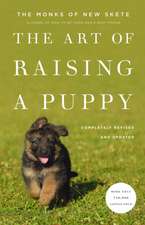The Other End of the Leash: Why We Do What We Do Around Dogs
Autor Patricia B. McConnellen Limba Engleză Paperback – 31 mar 2003
After all, although humans and dogs share a remarkable relationship that is unique in the animal world, we are still two entirely different species, each shaped by our individual evolutionary heritage. Quite simply, humans are primates and dogs are canids (like wolves, coyotes, and foxes). Since we each speak a different native tongue, a lot gets lost in the translation.
The Other End of the Leash demonstrates how even the slightest changes in your voice and the way you stand can help your dog understand what you want. Once you start to think about your own behavior from the perspective of your dog, you’ll understand why much of what appears to be doggy-disobedience is simply a case of miscommunication. Inside you will learn
• How to use your voice so that your dog is more likely to do what you ask.
• Why “getting dominance” over your dog is a bad idea.
• Why “rough and tumble primate play” can lead to trouble–and how to play with your dog in ways that are fun and keep him out of trouble.
• How dogs and humans share personality types–and why most dogs want to live with benevolent leaders rather than “alphawannabees!”
In her own insightful, compelling style, Patricia McConnell combines wonderful true stories about people and dogs with a new, accessible scientific perspective on how they should behave around each other. This is a book that strives to help you make the most of life with your dog, and to prevent problems that might arise in that most rewarding of relationships.
From the Hardcover edition.
Preț: 100.85 lei
Nou
19.30€ • 20.96$ • 16.21£
Carte disponibilă
Livrare economică 01-15 aprilie
Livrare express 15-21 martie pentru 26.99 lei
Specificații
ISBN-10: 034544678X
Pagini: 272
Dimensiuni: 140 x 209 x 16 mm
Greutate: 0.24 kg
Ediția:Trade Pbk.
Editura: BALLANTINE BOOKS
Notă biografică
Patricia McConnell, Ph.D., is an Adjunct Assistant Professor of Zoology at the University of Wisconsin-Madison and an expert applied animal behaviorist. Her company, Dog’s Best Friend, Ltd., specializes in family dog-training and treating aggression in dogs, and she is an immensely popular speaker around the country. She is the co-host of Calling All Pets, an animal behavior advice show syndicated to a hundred public radio stations, and works daily with four dogs (three border collies and a Great Pyrenees) on her sheep farm outside of Madison. Her Web site is www.dogsbestfriendtraining.com.
From the Hardcover edition.
Extras
The Importance of Visual Signals Between People and Dogs
Being an Applied Animal Behaviorist who works with aggressive dogs in my office is one thing. Working with them on a stage in front of a couple of hundred people is another. In a private consultation, all your attention is focused on the dog, but when you're doing a demonstration, your focus is divided between the dog and the audience. Important signals may last only a tenth of a second and be no bigger than a quarter of an inch, so you can get into trouble trying to attend to both an audience and a problem dog at the same time. There's a kind of Evel Knievel feeling about working with an aggressive dog up on a stage. You prepare meticulously to have all the odds in your favor. You get a good night's sleep, eat healthy food, and interview the dog owner extensively beforehand. You work with good, reliable people on whom you can count. And then you hit the ramp and hope you'll make it over the canyon.
The Mastiff I was working with at one seminar must have weighed more than 200 pounds, with a head the size of an oven. He had been lunging at strangers for the last several months, scaring his owners as much as their friends. Tossing treats steadily, I got closer and closer to him while I talked to the audience about what I was doing. Out of the corner of my eye, I saw that the Mastiff looked relaxed, anticipating another treat, breathing normally. I turned my attention to a question from the audience, as I continued tossing treats, and took one step closer. I was now only a few feet away.
Donna's eyes alerted me. I had glanced at Donna Duford, a wise and experienced professional dog trainer, and by the look on her face, I knew I was in trouble. The Mastiff was standing right beside me but had become chillingly still. I glanced in his direction, but looked directly into his eyes, although only for a microsecond--a mistake, and a stupid one at that. Direct eye contact with a nervous dog is a beginner's mistake that you either learn to avoid or you get out of the business.
The dog exploded like a freight train of teeth and muscle, lunging right at my face. His growl-barks shook the building. I did what every highly trained professional does in that circumstance. I backed up.
Little Movements Have Big Effects
If I had not made eye contact with the Mastiff, if my eyes had moved some fraction of an inch over to the left or right, he wouldn't have lunged. All that ballistic power would've sat, quietly watching, if I had changed the path of my gaze a quarter of an inch. A barely perceptible change in my behavior would have resulted in the stunningly obvious difference between a 200-pound dog sitting quietly or launching toward my face.
That story may be a bit dramatic, but the same impact of subtle movements underlies each and every one of your interactions with your dog. Dogs are brilliant at perceiving minute changes in our bodies and assume each tiny motion has meaning. Small movements that you make result in huge changes in your dog's behavior. If you learn anything from this book, learn that. The examples are endless. Standing straight with your shoulders squared rather than slumped can make the difference in whether your dog sits or not. Shifting your weight forward or backward, almost imperceptibly to a human, is a neon sign to a dog. Changes in the way that your body leans are so important that an incline of half an inch backward or forward can lure a frightened stray dog toward you or chase her away. Whether you breathe deeply or hold your breath can prevent a dogfight or cause one. I've worked with aggressive dogs every week for thirteen years, and I've seen repeatedly that sometimes tiny movements can defuse a dangerous situation--or create one.
When I asked a veterinary student what she had learned after spending two weeks with me, she said, "I never realized how important the details of my actions were--how tiny changes in things like shifting your weight can have huge effects on an animal's behavior." This information doesn't seem to be obvious to any of us. But how strange, given how important minuscule movements are within our own species. As I asked in the introduction, how far do you have to raise an eyebrow to change the message on your face? Go look in the mirror, right now if it's convenient. Raise the corners of your mouth just the slightest bit and see how much it changes the "look" on your face. Watch the face of one of your family members and think about how little it has to change to convey information. That information, what we learn about others by watching for small movements in their faces and bodies, is critical to our relationship with them. It is also deeply rooted in our primate heritage. Primate species vary tremendously, from a 4-ounce, sap-eating pygmy marmoset to a 500-pound, leaf-chomping gorilla. But all primates are intensely visual, and all rely on visual communication in social interactions. Baboons lift their eyebrows as a low-intensity threat. Common chimps pout their lips in disappointment. Rhesus macaque monkeys threaten with an open mouth and a direct stare. Both chimpanzees and bonobos reach out with their hand to reconcile after a spat. We primates use visual signals as a bedrock of our social communications, and so do dogs.
Our dogs are tuned to our body like precision instruments. While we're thinking about the words we're using, our dogs are watching us for the subtle visual signals they use to communicate to one another. Any article or book on wolves will describe dozens of visual signals that are key to the social interactions of pack members. In the book Wolves of the World, one of the world's authorities on wolf behavior, Erik Zimen, describes forty-five movements that wolves use in social interactions. By comparison he mentions vocalizations only three times. That doesn't mean that whines and growls aren't critically important in the social relationships of wolves. They are. But the depth and breadth of visual signals--of subtle head cocks, shifts in weight forward or backward, stiffening or relaxing of the body--are vast in wolves, and every interaction I've ever had with a dog suggests that visual signals are equally integral to communication in dogs.
So here we have two species, humans and dogs, sharing the tendencies to be highly visual, highly social, and hardwired to pay attention to how someone in our social group is moving, even if the movement is minuscule. What we don't seem to share is this: dogs are more aware of our subtle movements than we are of our own. It makes sense if you think about it. While both dogs and humans automatically attend to the visual signals of our own species, dogs need to spend additional energy translating the signals of a foreigner. Besides, we are always expecting dogs to do what we ask of them, so they have compelling reasons to try to translate our movements and postures. But it's very much to our own advantage to pay more attention to how we move around our dogs, and how they move around us, because whether we mean to or not, we're always communicating with our bodies. Surely it'd be a good thing if we knew what we were saying.
Once you learn to focus on the visual signals between you and your dog, the impact of even tiny movements will become overwhelmingly obvious. It's really no different from any sport in which you train your body to move certain ways when you ask it to. All athletes have to become aware of what they are doing with their bodies. It's the same in dog training. Professional dog trainers are aware of exactly what they're doing with their bodies while they're working with a dog. That's not true of most dog owners, whose dogs minute by minute try to make sense of the stir-fry of signals that radiate from their owners.
Dogs never seem to lose their keen awareness of our slightest movements. I taught my dogs to sit when I unintentionally brought my hands together and clasped them at waist level. It seems that I made this motion, without even knowing it, when I called my dogs to come and was getting ready to ask them to do something else. Often I would first ask them to "sit," so my dogs quickly learned that clasped hands were usually followed by a "sit" signal. Apparently they figured that they might as well save us both time and do it right away. Every dog owner illustrates this every day. Maybe your dog runs to the door when you reach for your jacket. Perhaps you've played chase with your dog, and now, each time you lean forward, your dog dashes away from you. Most people move their hand or finger when they ask their dog to sit, even if they're not aware of it. But your dog is, and your action is probably the cue that's most relevant to him.
When I started professionally training dogs and their humans, one of the first things that hit me was how the owners focused on the sounds that they made, while the dogs appeared to be watching them move. This observation compelled me and two undergraduate students, Jon Hensersky and Susan Murray, to do an experiment to see if dogs paid more attention to sound or vision when learning a simple exercise. The students taught twenty-four six-and-a-half-week-old puppies to "sit" to both a sound and a motion.1 Each pup got four days of training to both signals given together, but on the fifth day the trainer only presented one signal at a time. In a randomized order the pup either saw the trainer's hand move or heard the beeplike "sit" signal. We wanted to see whether one type of signal, acoustic or visual, resulted in more correct responses. It did: twenty-three of the twenty-four puppies performed better to the hand motion than to the sound, while one puppy sat equally well to either. The Border Collies and Aussies, as you might predict, were stars at visual signals, getting a total of thirty-seven right out of forty possible (and only six out of forty right to acoustic signals). The Dalmatian litter sat to sixteen of twenty visual signals but only four of twenty acoustic ones. The Cavalier King Charles Spaniels showed the smallest difference between visual and acoustic signals, with eighteen right of twenty possible visual signals and ten of twenty acoustic ones. If you have a Beagle or a Miniature Schnauzer, you will not be shocked to learn that these puppies sat, in total, for thirty-two of the forty times that they saw the "sit" visual signal and exactly zero of the forty times that they heard the acoustic signal. That'll teach you to call your Beagle to come when she's chasing a rabbit in the woods.
I'm cautious about this experiment, because it's a difficult piece of research to pull off cleanly. Unless the motion and sound had been completely automated, I couldn't guarantee that they were presented for exactly the same duration. Since the students had previously given the pups treats from their other hand, did that predispose the pups to focus on a hand signal? How could we be sure that we were presenting an equal "amount," or intensity, of each signal? A larger sample size of puppies would have been better, and so forth. But the trainers were ignorant of the real hypothesis (I told them it related to genetics and sex). I videotaped the training sessions and found that the motion and the sound began and ended within a few hundredths of a second of each other, and we worked hard to get as clean a test as we could under the circumstances. Given the ease with which dogs learn visual signals, and the universal phenomenon of mammalian brains' selectively attending to certain stimuli over others, I suspect that the results are meaningful. Ironically people often enthuse over their dog's "amazing" ability to learn a hand signal, as though that were a particularly advanced behavior. In actuality your dog's response to your voice is the miracle!
Hey, Human! I'm Trying to Tell You Something!
Visual though primates may be, we humans often miss the signals that our dogs are sending us. For example, in my seminars I do a demonstration in which I pet and praise my Border Collie Pip for giving me a ball back. Pip is my sleeper Border Collie, who looks a bit like a goofy Labrador cross when in fact she's from pristine sheepdog lineage. But she loves balls like life itself, so to reward her for giving me the ball back, I coo to her and lavishly stroke her head. People watching respond to my efforts to praise Pip and seem to feel really good when I'm done. They feel so good that they give me an A+ when I ask them to grade my efforts to make Pip glad that she gave me the ball. But I give myself a D, because although the audience enjoyed hearing my praise and seeing me pet her, Pip just wanted the ball. I repeat the exercise, this time telling the audience to pay careful attention to Pip's face. Her reaction is obvious once you focus your attention on her. She ignores my sweet words, squints her eyes, ducks her head away from my hand, and presses forward, staring like a laser at the ball. Pip is no different from most of our dogs, who love petting and praise in some contexts but not others. After all, even if you adore a good massage, do you want one in the middle of an important meeting or a close tennis match? Why on earth would a dog, even one who lives to be stroked, want petting in every possible context in her life? We wouldn't, no matter how much we love a good rubdown.
As soon as the audience has learned to focus on Pip's reactions rather than their own, they get it. Pip's avoidance of my hand and obvious impatience to get the ball back aren't subtle at all. But for some reason we humans tend not to pay attention to the visual signals that our dogs send us. Hundreds of clients who come to my office for help with their dogs have described their pet's aggression as having appeared "out of the blue." Yet I could plainly see, even as the owners were talking to me, that the dog was clearly communicating, "Stop petting me like that. I'm going to bite you if you don't stop."
From the Hardcover edition.
Descriere
The Other End of the Leash shares a revolutionary, new perspective on our relationship with dogs, focusing on our behavior in comparison with that of dogs. An applied animal behaviorist and dog trainer with more than twenty years experience, Dr. Patricia McConnell looks at humans as just another interesting species, and muses about why we behave the way we do around our dogs, how dogs might interpret our behavior, and how to interact with our dogs in ways that bring out the best in our four-legged friends.
After all, although humans and dogs share a remarkable relationship that is unique in the animal world, we are still two entirely different species, each shaped by our individual evolutionary heritage. Quite simply, humans are primates and dogs are canids (like wolves, coyotes, and foxes). Since we each speak a different native tongue, a lot gets lost in the translation.
The Other End of the Leash demonstrates how even the slightest changes in your voice and the way you stand can help your dog understand what you want. Once you start to think about your own behavior from the perspective of your dog, you’ll understand why much of what appears to be doggy-disobedience is simply a case of miscommunication. Inside you will learn
• How to use your voice so that your dog is more likely to do what you ask.
• Why “getting dominance” over your dog is a bad idea.
• Why “rough and tumble primate play” can lead to trouble–and how to play with your dog in ways that are fun and keep him out of trouble.
• How dogs and humans share personality types–and why most dogs want to live with benevolent leaders rather than “alphawannabees!”
In her own insightful, compelling style, Patricia McConnell combines wonderful true stories about people and dogs with a new, accessible scientific perspective on how they should behave around each other. This is a book that strives to help you make the most of life with your dog, and to prevent problems that might arise in that most rewarding of relationships.
From the Hardcover edition.






















